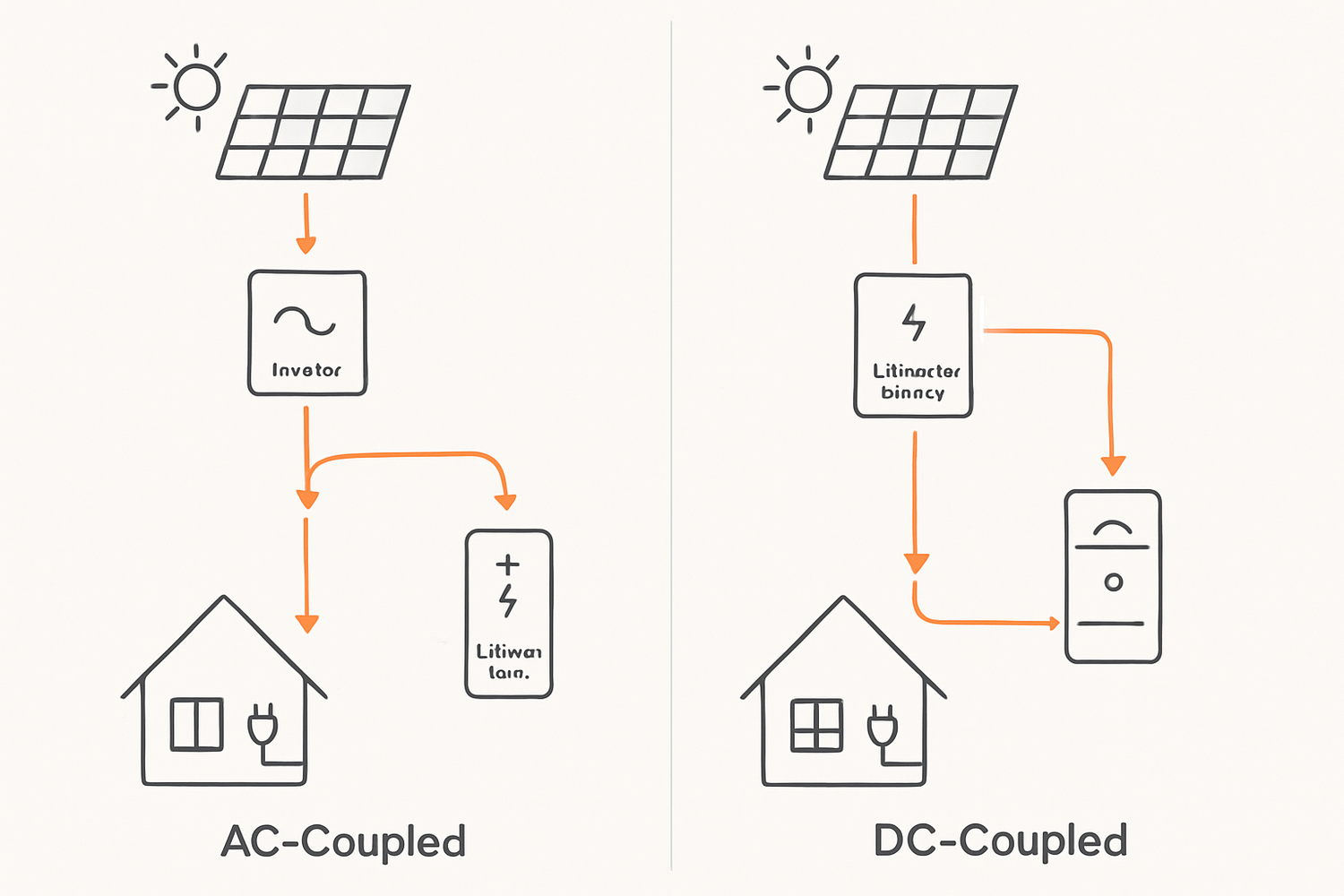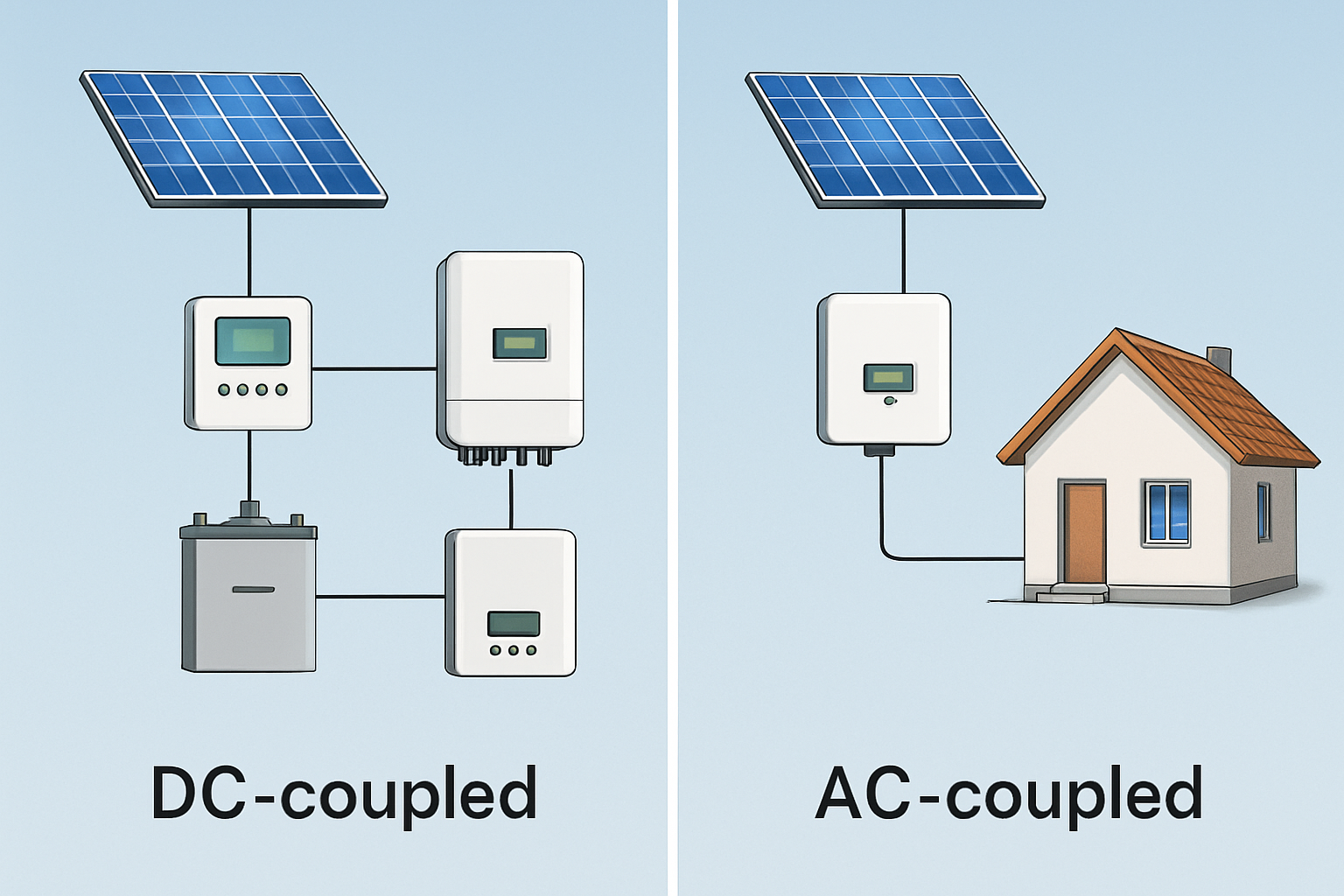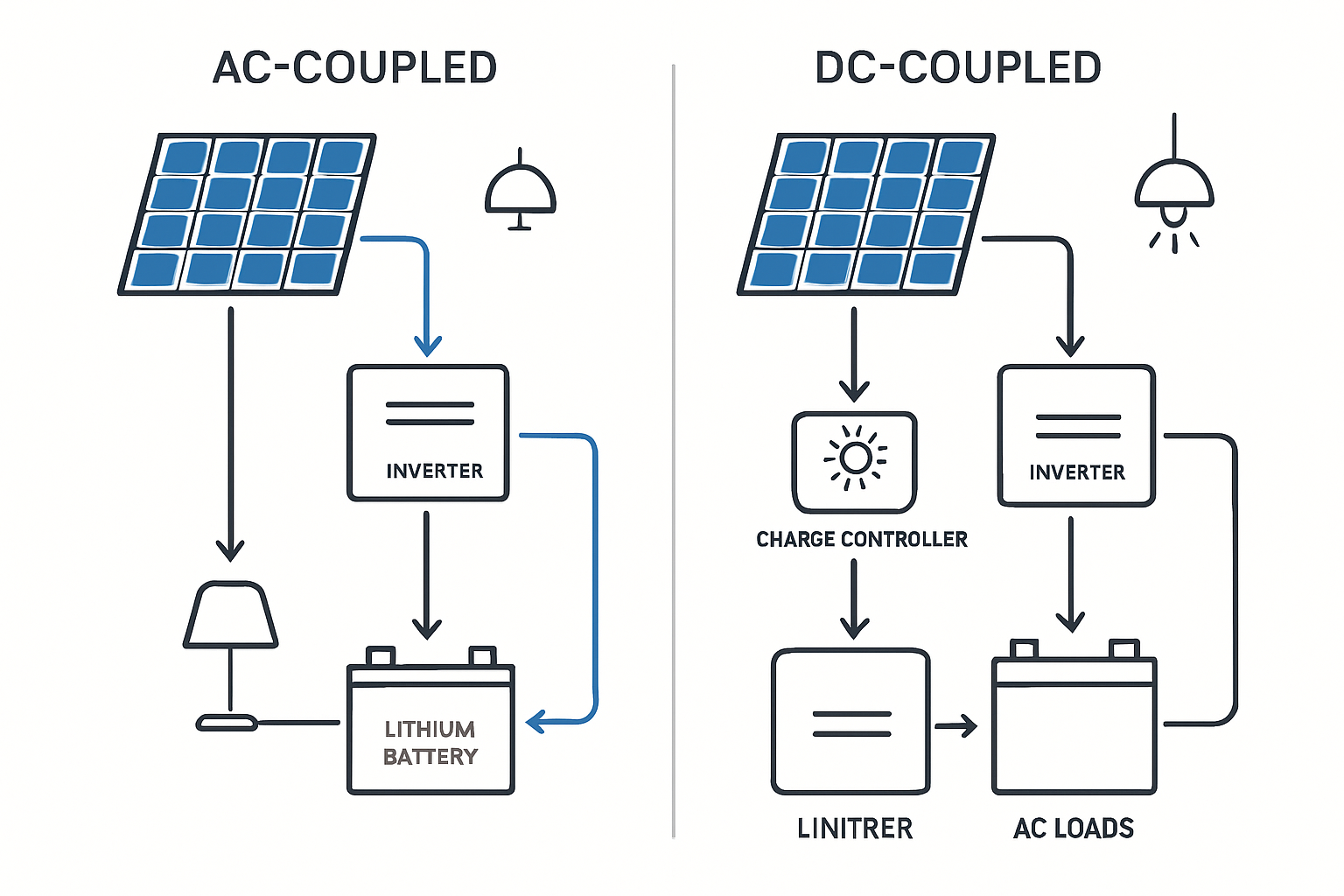Adding a lithium-ion solar battery to a solar panel system is a major step toward achieving energy independence. It allows you to store excess energy generated during the day for use at night or during outages. When planning this addition, a key technical decision is how to connect, or 'couple,' the battery to your system. The two primary methods are Alternating Current (AC) coupling and Direct Current (DC) coupling. This choice affects system efficiency, cost, and installation complexity.
Understanding the Fundamentals: AC vs. DC Power
To grasp the difference between coupling methods, it's helpful to know the basics of the two types of electricity involved. The flow of power and the points of conversion are what distinguish these two architectures.
What is DC Power?
Direct Current (DC) is the type of electricity generated by solar panels and stored in batteries. Think of it as a one-way street where electrical energy flows in a single, constant direction. Your lithium iron phosphate battery pack, whether it's a 12v 100ah lithium ion battery or a larger 48v LiFePO4 battery, operates exclusively on DC power.
What is AC Power?
Alternating Current (AC) is the standard form of electricity used by the utility grid and nearly all appliances in your home, from your refrigerator to your television. In contrast to DC, AC power rapidly changes direction, flowing back and forth. This characteristic allows it to travel efficiently over long distances.
The Role of the Inverter
Since your solar panels produce DC and your home uses AC, a device called an inverter is necessary to convert the power from one form to another. The fundamental difference between AC and DC coupling is *where* this DC-to-AC conversion happens in relation to your solar battery.
A Closer Look at DC Coupling
In a DC-coupled system, the energy flows in a more direct path from its source to storage, minimizing conversions along the way. This architecture is often favored for new, fully integrated solar energy storage systems.
How DC Coupling Works
The setup involves solar panels sending DC power to a solar charge controller. This device regulates the power, which then charges the DC battery bank directly. When your home needs power, a central hybrid inverter draws from the battery, converting the stored DC electricity into AC for your appliances. The path is: Solar Panels (DC) -> Charge Controller -> Battery (DC) -> Inverter -> Home (AC).
Advantages of DC-Coupled Systems
The main benefit of DC coupling is higher efficiency. Because the energy from the solar panels charges the battery without being converted to AC first, round-trip efficiency can be as high as 98%. This means less energy is lost during the storage and retrieval process. This efficiency makes DC coupling particularly well-suited for off-grid solar solutions where maximizing every generated watt is critical. It can also be more cost-effective for new installations because it often requires a single hybrid inverter to manage both solar and battery functions.
Limitations of DC Coupling
DC-coupled systems can be more complex to install and configure. Retrofitting them onto an existing grid-tied solar system is often difficult and may require replacing the existing solar inverter with a compatible hybrid model. Additionally, the entire system can depend on a single hybrid inverter, creating a central point of failure; if the inverter goes down, both solar generation and battery power can be lost.
Exploring AC Coupling
AC coupling offers a more modular approach, making it the go-to choice for adding a battery to an existing solar installation. It treats the solar array and the battery system as two independent components.
How AC Coupling Works
In an AC-coupled system, the DC power from the solar panels first goes to a standard grid-tied solar inverter, which converts it to AC power for immediate use in the home. Any excess AC power is then sent to a separate battery inverter. This second inverter converts the AC power *back* to DC to charge the lithium battery storage. When power is needed from the battery, it's converted back to AC again.
Advantages of AC-Coupled Systems
The primary advantage is the ease of retrofitting. You can add an AC-coupled battery to almost any existing grid-tied solar system without altering the original setup. This modularity also enhances resilience; since the solar panels and battery have separate inverters, a failure in one does not disable the other. It also provides flexibility to charge the battery from the grid, which is useful for taking advantage of time-of-use electricity rates.
Limitations of AC Coupling
The main drawback is slightly lower efficiency. The multiple conversions (DC-AC-DC to store, then DC-AC to use) result in some energy loss. The round-trip efficiency for AC-coupled systems is typically between 90-94%. While this difference seems small, it can add up over the lifespan of the system. These systems also require two inverters (one for solar, one for the battery), which can sometimes increase the initial hardware cost.
Performance and Efficiency: A Head-to-Head Comparison
Choosing between AC and DC coupling involves weighing the trade-offs between efficiency, flexibility, and cost. The right choice depends entirely on your specific situation. According to the U.S. Department of Energy, improving conversion efficiency is a key goal for making solar technologies more cost-competitive. For a deeper look at what impacts battery performance, the ultimate reference for solar storage performance provides detailed metrics.
| Feature | DC Coupling | AC Coupling |
|---|---|---|
| Round-Trip Efficiency | Higher (up to 98%) | Slightly Lower (90-94%) |
| Best for New Systems | Yes, often preferred | Viable, but less efficient |
| Best for Retrofitting | Difficult and costly | Excellent, easy to install |
| System Complexity | Can be more complex | More straightforward, modular |
| Off-Grid Capability | Excellent, highly efficient | Possible, but less efficient |
| Resilience | Single point of failure | Independent systems, more resilient |
Final Thoughts on Coupling Your Lithium-Ion Battery
Ultimately, there is no single 'best' way to couple a lithium-ion solar battery. The decision hinges on your circumstances. For a brand-new home battery storage system, especially in an off-grid setting, the superior efficiency of DC coupling makes it a compelling choice. For homeowners looking to add storage to an existing solar array, the simplicity and modularity of AC coupling are almost always the more practical and cost-effective path. As noted in the International Energy Agency's 'Batteries and Secure Energy Transitions' report, the versatility of battery storage is crucial for enabling clean energy solutions. Both coupling methods are proven technologies that effectively integrate a deep cycle lithium battery into your energy system, helping you achieve greater control over your power.
Frequently Asked Questions
Can you use AC and DC coupling in the same system?
Yes, some advanced hybrid inverters and energy storage solutions can manage both AC and DC inputs simultaneously, offering maximum flexibility. However, this is less common for typical residential setups and adds complexity.
Does the type of lithium battery affect the coupling choice?
Not directly. Both AC and DC coupling work well with high-performance lithium iron phosphate (LiFePO4) batteries, such as a 12v 100ah lifepo4 lithium battery or a larger 48v lifepo4 battery. The more critical factors for compatibility are the battery's voltage and its communication protocol with the chosen inverter.
Which system is better for an off-grid solar solution?
DC-coupled systems are generally preferred for off-grid applications. The higher efficiency in charging the battery directly from the solar panels is a significant advantage when you are completely reliant on your own power generation and storage.





Leave a comment
All comments are moderated before being published.
This site is protected by hCaptcha and the hCaptcha Privacy Policy and Terms of Service apply.